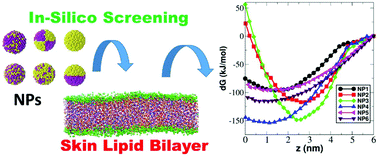In-silico design of nanoparticles for transdermal drug delivery application†
Abstract
Nanoparticles are used in the medical field for various applications like cell imaging, drug delivery, gene and si-RNA delivery, to name a few. Designing nanoparticles for a given application, purely based on the trial and error experimentation, requires a lot of time and effort. In this study we show that computer simulations could help in designing nanoparticles for drug delivery thus reducing the time and cost associated with their design, development and deployment. The permeation of nanoparticles, having various surface chemistries and patterns, through the skin lipid bilayer was studied using constrained and unconstrained molecular dynamics simulations. Interestingly, the permeation mechanism of nanoparticles having the same surface chemistry but different patterns was found to be completely different. Nanoparticles (NPs) were screened based on the free energy of permeation through the skin lipid bilayer. The behavior of the screened NPs was further validated with unconstrained simulations using the skin lipid bilayer. Nanoparticles thus screened through both of the techniques were further used for the co-delivery of a model protein into the skin lipid bilayer. It was observed that the nanoparticles having a 2 : 1 homogeneous ratio of hydrophobic to hydrophilic regions were the most promising in transdermal delivery of proteins. The obtained results are in line with the results of recent permeation experiments on cell and plasma membrane. Our study could help in in-silico design of nanoparticles for delivery of actives through skin. These in-silico experiments thus could help speed up the development process by guiding formulation chemists.



 Please wait while we load your content...
Please wait while we load your content...